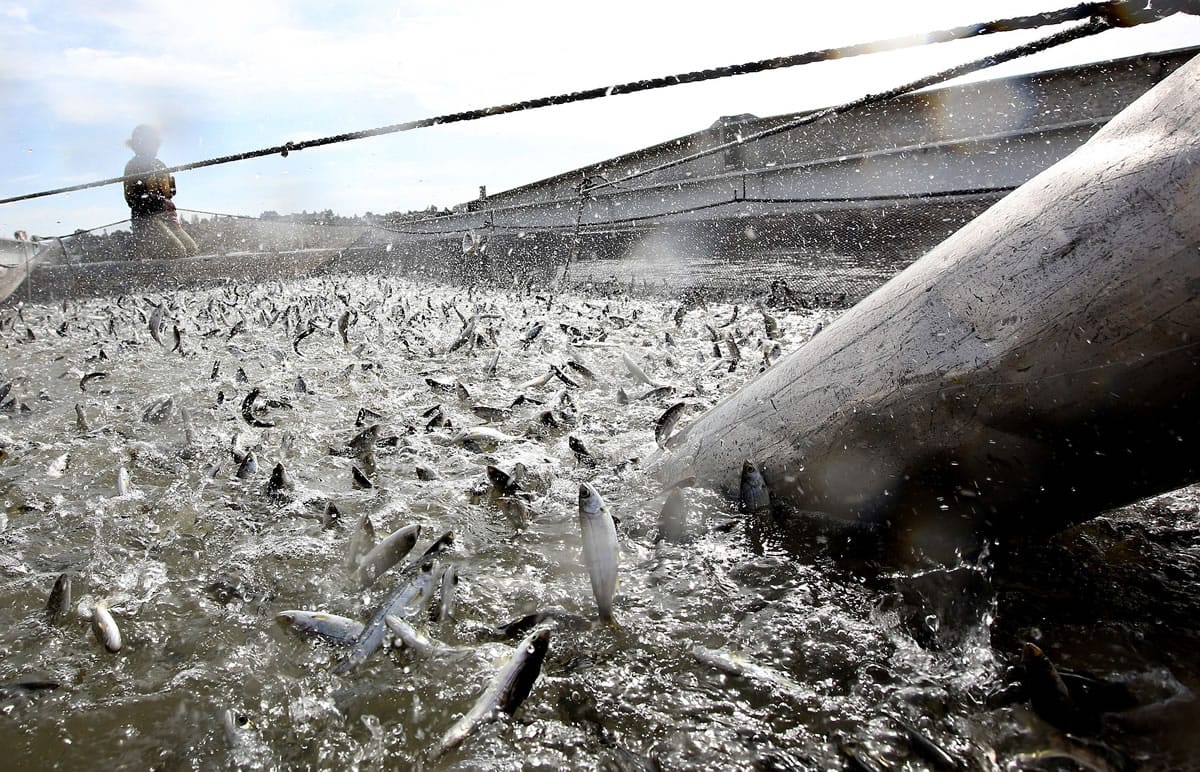LAGUNITAS, Calif. — What do you do when you have 30 million young salmon ready for their big journeys downstream, but drought and development have dried your riverbeds to sauna rocks? In California this year, you give the fish a ride.
State and federal wildlife agencies in California are deploying what they say is the biggest fish-lift in the state’s history through this month, rolling out convoys of tanker trucks to transport a generation of hatchery salmon downstream to the San Francisco Bay. California is locked in its driest four-year stretch on record, making the river routes that the salmon normally take to the Pacific Ocean too warm and too shallow for them to survive.
“It’s huge. This is a massive effort statewide on multiple systems,” said Stafford Lehr, chief of fisheries for the California Department of Fish and Wildlife, which since February has been rolling out four to eight 35,000-gallon tanker trucks filled with baby salmon on their freeway-drive to freedom.
“We’re going to unprecedented drought,” Lehr said. “We’re forced to extreme measures.”
Drought and heavy use of water by farms and cities have devastated key native fish in California. Last year, for example, 95 percent of the state’s winter-run of Chinook salmon died. The fish is vital for California’s fishing industries and for the food chain of wildlife.
For the first time, all five big government hatcheries in California’s Central Valley for fall-run Chinook California salmon — a species of concern under the federal Endangered Species Act — are going to truck their young, release-ready salmon down to the Bay, rather than release them into rivers to make the trip themselves.
And California’s wild native fish should pack a sandwich and something to read; they’ll be spending a lot of the summer on the road too.
“Bone dry. Bone dry,” said fish biologist Don Portz of the U.S. Bureau of Reclamation, who is six years into an effort to restore the southernmost salmon stream in the U.S., the Central Valley’s San Joaquin River.
Drought, a dam and heavy use of the river’s water for irrigation have dried 60 miles of the San Joaquin. For the young salmon, whose life cycle for millions of years has involved travel from the river back and forth to the San Francisco Bay, that now means a 1½-hour ride down California Highway 99 in a pickup-mounted fish tank.
“You give them that taxi ride down, they make it to the ocean, and come back” in a few years for trapping and a taxi ride back up to spawning grounds, Portz said.
The rolling fish rescues occurring up and down the West Coast haven’t always gone smoothly. In January, Oregon authorities charged a trucker with drunken driving after he hit a pole and flipped 11,000 juvenile salmon out on the roadway, where they died.
One bucket-full at a time
For some of California’s native fish, the rescue from drought often is by bucket, not truck.
Near the town of Lagunitas, in Northern California’s Marin County, watershed biologist Preston Brown stood ankle-high in a coastal tributary, searching for endangered California coastal Coho salmon and other, native fish. Decades ago, so many coho salmon filled the water that the noise of their jumping kept people in nearby houses up at night. On this day, Brown and his team find none.
Starting in June, months earlier than usual because of the drought, Brown and others with local environment group Salmon Protection and Watershed Network, will search the waterway. In cooperation with wildlife agencies, they will try to rescue coho and other fish stuck in drying pools of water 4 or 5 inches deep.
Sometimes, Brown said, the bucket brigades get there too late for the stranded salmon. “If they survived the raccoons” and other predators, “they dried up and died,” Brown said.
Lehr, the fisheries chief, expects some individual steelhead trout in Southern California will get truck rides two or three times this summer, as parts of rivers and creeks disappear.
As a last resort, when some rivers have no pools of water left to shelter fish, wildlife officials will remove survivors to a hatchery to wait out the drought. Two such isolated native species from dried-up waterways have been living in government hatcheries since last year, snacking on flies that rangers catch in bug-zappers for them, Lehr said, and waiting for wetter times.



